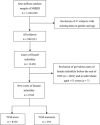Chinese Herbal Products for Female Infertility in Taiwan: A Population-Based Cohort Study
- PMID: 26986137
- PMCID: PMC4839918
- DOI: 10.1097/MD.0000000000003075
Chinese Herbal Products for Female Infertility in Taiwan: A Population-Based Cohort Study
Abstract
Female infertility and low birth rate are significant public health issues with profound social, psychological, and economic consequences. Some infertile women resort to conventional, complementary, or alternative therapies to conceive. The aim of this study was to identify the Chinese herbal products (CHPs) most commonly used for female infertility in Taiwan. The usage of traditional Chinese medicine (TCM) and the frequency of CHP prescriptions to infertile women were determined based on a nationwide 1-million randomly sampled cohort of National Health Insurance Research Database beneficiaries. Descriptive statistics and multiple logistic regression analysis were employed to estimate the adjusted odds ratio (aOR) for TCM usage and potential risk factors. In total, 8766 women with newly diagnosed infertility were included in this study. Of those, 8430 (96.17%) had sought TCM treatment in addition to visiting the gynecologist. We noted that female infertility patients with risk factors (e.g., endometriosis, uterine fibroids, or irregular menstrual cycle) were more likely to use TCM than those without TCM medication (aOR = 1.83, 1.87, and 1.79, respectively). The most commonly used formula and single CHP were Dang-Gui-Sha-Yao-San (17.25%) and Semen Cuscutae (27.40%), respectively. CHP formula combinations (e.g., Dang-Gui-Sha-Yao-San plus Wen-Jing-Tang 3.10%) or single Chinese herbal combinations (e.g., Semen Cuscutae plus Leonurus japonicus 6.31%) were also commonly used to treat female infertility. Further well-conducted, double-blind, randomized, placebo-controlled studies will be needed to evaluate the efficacy and safety of these CHP combinations for female infertility.
Conflict of interest statement
The authors have no conflicts of interest to disclose.
Figures



Similar articles
-
The traditional Chinese medicine prescription pattern of patients with primary dysmenorrhea in Taiwan: a large-scale cross sectional survey.J Ethnopharmacol. 2014 Mar 14;152(2):314-9. doi: 10.1016/j.jep.2014.01.002. Epub 2014 Jan 10. J Ethnopharmacol. 2014. PMID: 24417866
-
Characteristics of traditional Chinese medicine use in patients with rheumatoid arthritis in Taiwan: A nationwide population-based study.J Ethnopharmacol. 2015 Dec 24;176:9-16. doi: 10.1016/j.jep.2015.10.024. Epub 2015 Oct 23. J Ethnopharmacol. 2015. PMID: 26481605
-
The use of Chinese herbal products and its influence on tamoxifen induced endometrial cancer risk among female breast cancer patients: a population-based study.J Ethnopharmacol. 2014 Sep 11;155(2):1256-62. doi: 10.1016/j.jep.2014.07.008. Epub 2014 Jul 15. J Ethnopharmacol. 2014. PMID: 25048609
-
Application of traditional Chinese medicine in the treatment of infertility.Hum Fertil (Camb). 2003 Nov;6(4):161-8. doi: 10.1080/1464770312331369433. Hum Fertil (Camb). 2003. PMID: 14614194 Review.
-
Future development of global regulations of Chinese herbal products.J Ethnopharmacol. 2012 Apr 10;140(3):568-86. doi: 10.1016/j.jep.2012.02.029. Epub 2012 Feb 25. J Ethnopharmacol. 2012. PMID: 22373513 Review.
Cited by
-
A Survey of Utilization and Satisfaction of Korean Subfertility Treatment among Korean Women.Healthcare (Basel). 2024 Aug 12;12(16):1600. doi: 10.3390/healthcare12161600. Healthcare (Basel). 2024. PMID: 39201159 Free PMC article.
-
The Anti-Endometriotic Effect of Cyperi Rhizoma Extract, Inhibiting Cell Adhesion and the Expression of Pain-Related Factors through Akt and NF-kB Pathways.Medicina (Kaunas). 2022 Feb 23;58(3):335. doi: 10.3390/medicina58030335. Medicina (Kaunas). 2022. PMID: 35334511 Free PMC article.
-
Treatment of Cesarean Scar Pregnancy with Traditional Chinese Medicine and Warming Moxibustion.Evid Based Complement Alternat Med. 2022 May 17;2022:5835569. doi: 10.1155/2022/5835569. eCollection 2022. Evid Based Complement Alternat Med. 2022. PMID: 35620401 Free PMC article.
-
Effect of Total Flavones from Cuscuta Chinensis on Anti-Abortion via the MAPK Signaling Pathway.Evid Based Complement Alternat Med. 2018 Oct 2;2018:6356190. doi: 10.1155/2018/6356190. eCollection 2018. Evid Based Complement Alternat Med. 2018. PMID: 30369955 Free PMC article.
-
Complementary and alternative medicine use among infertile women attending infertility specialty clinics in South Korea: does perceived severity matter?BMC Complement Altern Med. 2019 Nov 6;19(1):301. doi: 10.1186/s12906-019-2727-x. BMC Complement Altern Med. 2019. PMID: 31694617 Free PMC article.
References
-
- Department of Household Registration Affairs, Ministry of Interior. Fertility Rates of Childbearing Age Women. Available at: http://sowf.moi.gov.tw/stat/year/y02-04.xls Accessed Jun 1, 2015.
-
- Rodriguez D. Female fertility: a conceptual and dimensional analysis. J Midwifery Womens Health. - PubMed
-
- Gurunath S, Pandian Z, Anderson RA, et al. Defining infertility: a systematic review of prevalence studies. Hum Reprod Update 2011; 17:575–588. - PubMed
-
- Juul S, Karmaus W, Olsen J. Regional differences in waiting time to pregnancy: pregnancy-based surveys from Denmark, France, Germany, Italy and Sweden. The European Infertility and Subfecundity Study Group. Hum Reprod 1999; 14:1250–1254. - PubMed
Publication types
MeSH terms
Substances
LinkOut - more resources
Full Text Sources
Other Literature Sources
Medical

